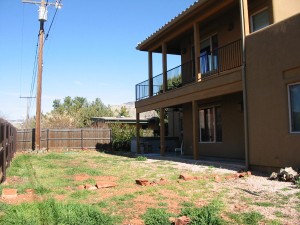February is a good time to prepare your vegetable garden for planting. But before you get too eager and start sowing seeds, do some preparation of the soil first. Here are some tips and guidelines any good Sedona landscape designer would tell their clients:
1) Check the condition of the soil.
Did the plants perform as expected? Was the soil amended properly last year? Does it have good drainage? Is it still too clayey? You may want to take a soil sample and have it tested by the local County Extension office. Here is a list of soil testing companies that can provide soil analysis.
You can have the Ph of your soil tested for free by the local extension office in either Prescott or Camp Verde.
Turn over the soil after folding in some organic matter, mulch or compost. If you do get a soil analysis, add the proper nutrients and other amendments necessary before you turn over the soil or use a roto-tiller. This will help compost any mulch or leaves you added and improve the tilth of the soil.
2) Check your irrigation system
If you have your garden set up with an automatic irrigation system, Depending on the type of irrigation system you are using, make any changes you need such as fixing leaks, adding a spray head, etc. If you have underground pipes, know where they are before you dig. You may want to make a diagram of the piping so you don’t forget from year to year.
If you use above the ground drip tubing or soaker hoses, pull that all away so you can properly amend the soil. Were all the planting beds getting adequate water from your system? You will need to make adjustments as you put the irrigation back in place.
I use an overhead spray system after starting out with soaker hose tubing. I found the soaker hoses were not releasing the same amounts of water from the beginning of the hose to the end resulting in patches of the garden getting over saturated. The overhead sprays provide complete coverage of the soil. Although this is not considered the best method for water conservation, it suits my needs for vegetable garden irrigation.
3) Plan your garden
Sedona is at the 4500 foot elevation level more or less, so we are right between the two ranges that differentiate lower Arizona from the upper elevations of northern Arizona. Here is a list of when to plant vegetables in Arizona depending on your region.
http://ag.arizona.edu/pubs/garden/mg/vegetable/guide.html
Cool-season vegetables include beet, lettuce, broccoli, spinach cabbage, carrot, onion, pea, potato, radish, and turnip. Cool season plants are frost tolerant and germinate in cold soil so they can be planted in winter or early spring depending on location. These crops need to mature during cooler periods rather than in the heat of the summer, so getting them out early in the garden or starting them in a mini greenhouse indoors is important.
Warm-season vegetables include sweet corn, sweet potato beans, cucumber, melons, pepper, pumpkin, eggplant, squash, and tomato. These are not frost tolerant and need warm temperatures to set their fruit. Temperatures too high will reduce quality such as sunburn, discoloration and less than ideal size.
Compensate for the mistakes and lessons learned from last year’s crop. Did you plant too many seeds of one type all at once and ended up with too much at one time? Be patient and stagger your seed plantings. Plan out a schedule of when to plant what and mark it on a calendar. It only takes a few minutes to sow some seeds.
Planting from seed is a lot cheaper than buying little 4” pots already leafed out. Consider planting early even before it may freeze again. Who knows when the last frost will occur and if you get lucky, you will have a head start, if not, you will not have lost much in your investment. But do wait till after the last frost or say mid April before you invest a lot in those 4” pots and risk losing them to a late frost.
4) Container plantings
In the practice of landscape design, the use of pots and containers adds an accessory element to the overall design. Pots are useful to feature individual plants and to decorate a patio area. Pots are suitable for many types of vegetable crops, especially vines types. I like to group pots and place a trellis behind them. If you have a lot of empty pots that you don’t otherwise need for perennial or annuals plants, you may want to use them for vegetables.
Be sure that the pot is big enough to handle the growth of the root system regardless of what type of plants you choose. Too many homeowners have collections of small pots and never invest in buying larger sizes to transplant their plants. Use these smaller pots as transitional containers as the plants grow just like nurseries do with 1 gallon, 2 gallon and 5 gallon containers.
Every landscape design in Sedona should have a garden of vegetables, perhaps sprinkled with some ornamental flowers and herbs. Adding colorful pots in strategic spots will make your garden look like you put some thought into the design and aesthetics.






